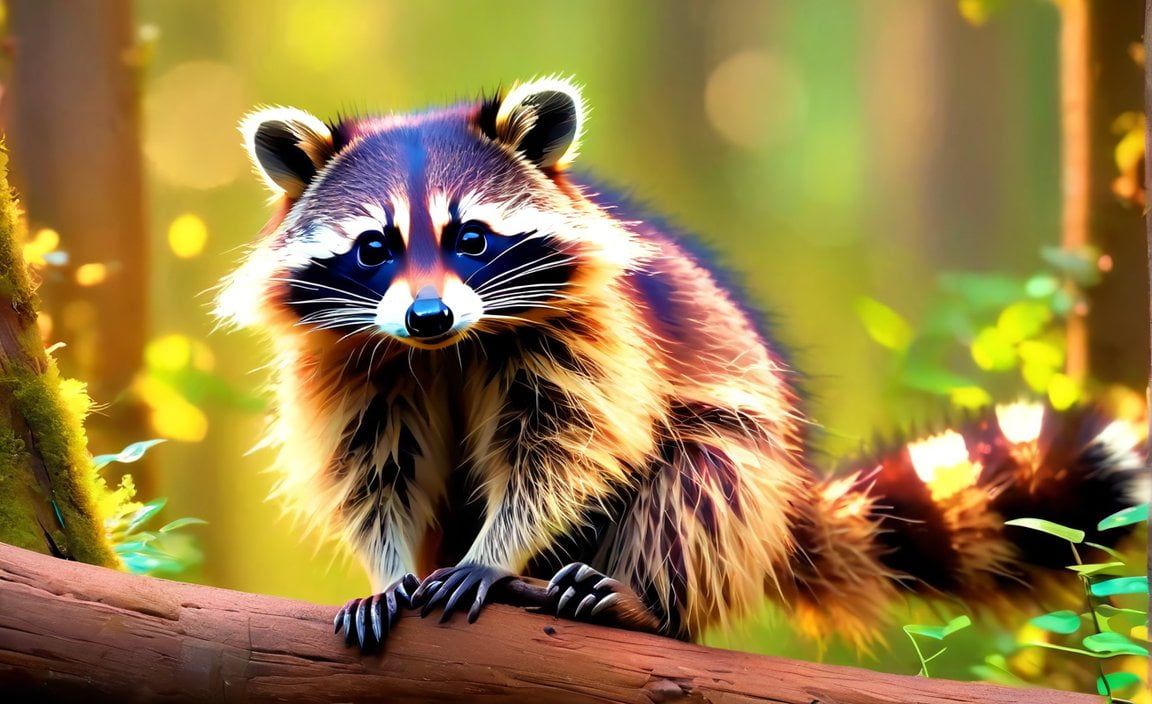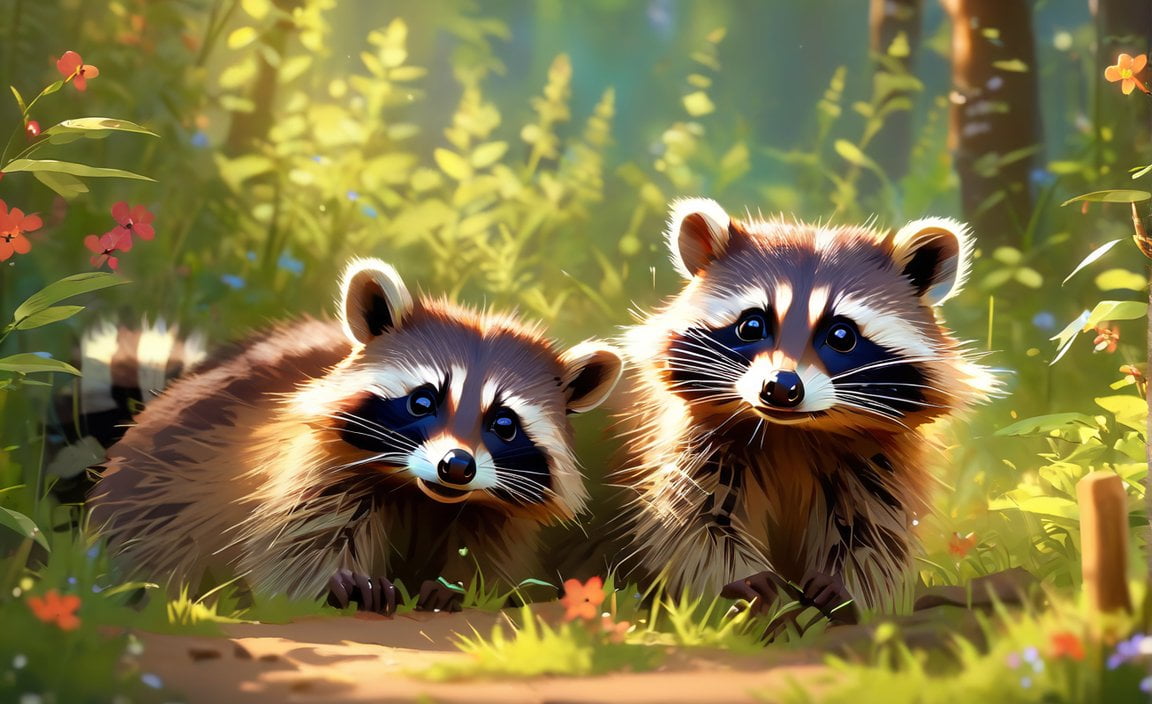If you’ve ever been captivated by the sight of a raccoon stealthily searching for food or mesmerized by their dexterous paws, then you’re in for a treat. In this article, we will delve into the intriguing world of these mischievous creatures and uncover five fascinating and unexpected facts about raccoons. From their intelligent antics to their remarkable adaptability, raccoons are sure to leave you in awe with their charming and endearing qualities. So, let’s embark on this journey and discover the hidden wonders of these fascinating creatures!

Key Takeaways:
- Raccoons have a relatively short lifespan in the wild (2-3 years) but can live up to 20 years in captivity.
- Raccoons possess a high level of intelligence and problem-solving skills.
- They enhance their sense of touch by wetting their paws, allowing them to explore their surroundings with dexterity.
- Raccoons have an omnivorous diet and can eat a variety of foods, including garbage in urban areas.
- While they don’t hibernate, raccoons sleep a lot during winter.
- Raccoons have dexterous hands similar to humans, enabling them to open doors, jars, and latches easily.
- They have excellent night vision, which helps them navigate and hunt in low-light conditions.
- Raccoons are capable of making over 50 different sounds to communicate with each other.
5 Fun Facts About Raccoons
Raccoons, with their distinctive mask-like face pattern and ringed tails, are fascinating creatures that never fail to capture our attention. From their remarkable intelligence to their dexterous hands, these creatures possess a range of surprising traits that make them truly unique. In this article, we will explore five fun and captivating facts about raccoons that will leave you in awe of their intelligence, adaptability, and charming antics.
1. Lifespan: Short But Sweet
Did you know that in the wild, raccoons have a relatively short lifespan of just 2-3 years? However, in captivity, these intelligent mammals can live up to an impressive 20 years[^1^]. Despite their short lives, raccoons manage to make the most of every moment, leaving a lasting impression on those who encounter them.
2. Intelligence: Masters of Problem-Solving
Raccoons are not just cute and cuddly; they are also exceptionally intelligent creatures. They have the remarkable ability to memorize and differentiate symbols, displaying quick learning skills that amaze researchers. When faced with challenges, raccoons have been known to solve problems with their ingenious problem-solving abilities[^2^]. These clever critters are always up for a mental challenge!
3. Enhanced Sense of Touch: Wet Paws Rule
Ever wondered how raccoons manage to identify objects and explore their surroundings with such dexterity? Well, it turns out that raccoons have a secret weapon: their enhanced sense of touch. By wetting their paws, raccoons increase their sense of touch, allowing them to navigate their environment effectively[^2^]. It’s like having mini superheroes with built-in touch boosters!
4. Omnivorous Diet: Foodie Fanatics
When it comes to food, raccoons are true foodie fanatics. These adaptable creatures have an omnivorous diet, which means they can eat almost anything. From acorns and leaves to worms and frogs, raccoons enjoy a diverse range of delicacies. In urban areas, they have also been known to feast on garbage, proving their ability to adapt to different environments. They truly are the gourmands of the animal kingdom[^3^].
5. Sleep Patterns: Lazy Days of Winter
Do raccoons hibernate during the winter? Surprisingly, raccoons do not hibernate, but they tend to sleep a lot more during this season. Instead of storing up fat reserves and becoming dormant, raccoons take it easy and conserve energy by sleeping for extended periods. So, the next time you spot a raccoon napping, remember that they’re merely enjoying their lazy winter days[^4^].
Unveiling the Fascinating World of Raccoons
Raccoons are truly captivating creatures that never cease to amaze us. Whether it’s their intelligence, dexterity, or adaptability, these mischievous mammals continue to fascinate wildlife enthusiasts around the world. From solving complex puzzles to indulging in a diverse menu of food, raccoons are proof that the animal kingdom is full of surprises. So, the next time you come across a raccoon, take a moment to appreciate their unique traits and the intriguing world they bring to our lives.
To dig deeper into the world of raccoons, check out these resources:
[^1^]: “Top 10 interesting facts about raccoons.” Depthworld. source
[^2^]: “11 Amazing Raccoon Facts for Kids.” Growkido. source
[^3^]: “10 Clever Facts about Raccoons.” Critter Pricker. source
[^4^]: “20 Furry Facts About Raccoons.” The Fact Site. source
Here are some fascinating facts about various animals that are sure to capture your interest:
5 fun facts about African bush elephants: Did you know that African bush elephants are the largest land animals on Earth? Discover more intriguing facts about these majestic creatures.
5 fun facts about aquatic animals: Dive into the depths of the ocean and explore amazing facts about aquatic animals. From vibrant coral reefs to graceful dolphins, you’ll be captivated by their incredible world.
5 fun facts about marine biology: Explore the fascinating field of marine biology and uncover the wonders of the underwater world. Discover how marine biologists study and protect ocean ecosystems.
5 fun facts about police dogs: Join us on a thrilling adventure into the world of police dogs! Find out how these highly trained canines assist law enforcement and become invaluable partners in crime prevention.
Click on the links above to discover these intriguing facts and broaden your knowledge about these incredible animals and fields of study.
Raccoons have fascinating and dexterous paws that allow them to manipulate objects
Raccoons are not your average backyard critters—they possess a set of remarkable tools at the end of their front paws that allow them to perform intricate tasks and manipulate objects with ease. In fact, their paws are so fascinating and dexterous that they often resemble miniature human hands. So, let’s dive into the world of these resourceful mammals and uncover five captivating facts about their incredible paws!
Fact 1: Highly Sensitive and Dexterous Front Paws
Raccoons possess highly sensitive and dexterous front paws that are meticulously designed for a wide range of activities. These paws are not only excellent for scratching and cleaning themselves—raccoons can also utilize them to climb trees, swim through water, dig burrows, and hold objects securely. You might be surprised to learn that raccoons’ paws can perform an array of tasks, allowing them to survive and thrive in various environments.
Fact 2: Unlocking Secrets with Paws
Raccoons have, quite literally, become the master locksmiths of the animal kingdom. Their paws are like built-in lockpicks, equipped with a pseudo-opposable thumb that enables them to manipulate objects with precision. This incredible adaptation allows raccoons to pry open containers, twist off lids, and even undo complex mechanisms to access their desired food. With their nimble fingers, raccoons effortlessly conquer obstacles that would leave most species searching for alternative solutions.
Fact 3: A Five-Fingered Grasp
Imagine having full control over each individual finger—this is precisely the situation for raccoons. The five toes on their front paws function essentially as five little fingers, providing them with the ability to grasp and manipulate objects in a remarkably human-like manner. Whether they are foraging for food, exploring their surroundings, or showcasing their undeniable curiosity, raccoons’ dexterity allows them to adapt to a wide variety of situations, utilizing their front paws as efficient tools.
Fact 4: Manipulating a World of Food
Thanks to their amazing paws, raccoons are incredibly adaptable in their search for sustenance. With their long fingers and dexterous front paws, they can explore and locate food in even the most challenging environments. These resourceful mammals have developed numerous techniques to obtain their meals, such as catching fish from streams or overturning rocks to find insects and crustaceans. From forests to urban areas, raccoons can use their paws to access a vast array of food sources.
Fact 5: Urban Survivors and Skilled Hunters
Raccoons have proven themselves to be astonishingly versatile animals, especially in urban environments. They have become experts at navigating the concrete jungles, using their paws to scavenge for food in garbage cans or open up containers left inadvertently accessible. Raccoons’ ability to adapt is not limited to urban settings; in their natural habitats, their paws play a crucial role in hunting. Whether they are grabbing fish from a river or capturing small prey on land, raccoons’ skilled hunting techniques owe much of their success to their remarkable paws.
Sources:
– Pest Pointers: 8 Fascinating Ways That Raccoons Use Their Paws
– Animalsman: What Do Raccoons Use Their Hands For?
Key Takeaways:
– Raccoons possess highly sensitive and dexterous front paws that resemble human hands.
– Their paws allow them to scratch, swim, climb, dig, sense, clean, hold, grab, open, pull, and protect.
– Raccoons can utilize their fingers to pry open containers and undo complex mechanisms to access food.
– The five toes on raccoons’ front paws function as five little fingers, enabling them to grasp and manipulate food.
– Raccoons are adaptable and use their dexterous front paws to find and feast on a wide variety of food.
Raccoon Behavior and Habits: An Interesting Exploration
Raccoons are truly fascinating creatures, captivating both wildlife enthusiasts and casual observers alike. From their mischievous antics to their intelligence and adaptability, raccoons never fail to impress. Today, we’ll be diving into the intriguing social behaviors of raccoons and how they live in close-knit family groups. So, gather around and let’s explore the world of these remarkable animals!
Raccoons: Masters of the Night
When the sun sets and darkness envelops the world, raccoons come to life. These clever critters are nocturnal by nature, meaning they are most active during the night and rest during the day. This behavior not only helps them avoid predators but also gives them an advantage in their search for food. By utilizing the cover of darkness, raccoons can navigate their environment more efficiently and find the sustenance they need to thrive.
Nimble Climbers with a Notable Look
If you’ve ever seen a raccoon, you’ve likely noticed their unique facial markings. Resembling a mask, these black furred patterns around their eyes not only give them a distinctive appearance but also serve as a camouflage mechanism in the wild. However, their distinctiveness doesn’t end there. Raccoons are also renowned for their exceptional climbing abilities. Thanks to their nimble fingers, which resemble tiny hands, they can easily grasp objects and scale vertical surfaces. This adaptation allows them to access various habitats, including attics and chimneys – sometimes leading to amusing encounters with humans!
Omnivorous Wonders of the Wild
When it comes to diet, raccoons are anything but picky eaters. These versatile mammals have an omnivorous diet, encompassing a wide range of food sources. Their meals include everything from fruits, nuts, and insects to small mammals, fish, and even garbage! Yes, raccoons are skilled scavengers and have adapted to take advantage of available food sources, including those found in urban areas. This adaptability is a testament to their remarkable survival skills.
Urban Pioneers: Thriving in New Environments
Speaking of urban areas, raccoons have proven themselves to be true pioneers. They have displayed an incredible ability to adapt to city life, effectively colonizing cities and suburbs. By embracing their resourcefulness, raccoons have found ways to utilize available food sources, such as trash cans and pet food. Their ability to thrive in an environment shaped by humans is nothing short of impressive and demonstrates their behavioral flexibility.
Captivating Social Behaviors
Now, let’s delve into the heart of our topic: the intriguing social behaviors of raccoons. These furry animals exhibit a complex social structure, living in close-knit family groups. Their social organization can be classified as a “three-class society,” resembling a hierarchy. Within these groups, raccoons exhibit communication and cooperation, allowing them to live and interact effectively with one another. This strong sense of social connection further highlights their intelligence and adaptability as they navigate the challenges of their dynamic environment.
Key Takeaways:
- Raccoons are primarily nocturnal animals, staying active during the night and resting during the day.
- Their distinctive facial markings serve both as a unique appearance and a camouflage mechanism.
- Raccoons have exceptional climbing abilities thanks to their nimble fingers, allowing them to access various habitats.
- With their omnivorous diet, raccoons can eat a wide range of food sources, including garbage in urban areas.
- Raccoons have showcased their adaptability by successfully colonizing cities and suburbs, utilizing available food sources.
- These fascinating creatures exhibit intriguing social behaviors, living in close-knit family groups.
(Source: Animal Behavior Corner – “Raccoon Habits”)
(Source: National Wildlife Federation – “Raccoon”)
Raccoons have a diverse diet and are skilled foragers
Raccoons are fascinating creatures known for their adaptability and intelligence. One of the most intriguing aspects of their behavior is their diverse diet and their exceptional foraging skills. In this article, we will explore five captivating facts about raccoons that highlight their ability to thrive in various environments and find food from a wide range of sources.
Raccoons are Opportunistic Eaters
Source: Nature Mentoring: What Do Raccoons Eat?
Raccoons have a reputation for being adaptable eaters, thanks to their excellent foraging abilities. They are omnivores, meaning they consume both plant and animal material. Their diets can vary based on their surroundings and the availability of food sources. Raccoons are opportunistic eaters, and their ability to find sustenance in diverse environments is truly remarkable.
From fruits, nuts, and seeds to insects, frogs, and fish, raccoons have a broad dietary range. They are not picky eaters, and their flexible nature allows them to survive in various habitats, including urban areas. Raccoons can even scavenge for food in garbage cans and dumpsters, displaying their incredible adaptability.
Raccoons are Skilled Foragers
Source: Science Facts: What Do Raccoons Eat?
Raccoons are highly skilled when it comes to foraging. They possess a remarkable sense of touch, which they enhance by wetting their paws. This wetting process allows them to navigate their environment effectively, especially when hunting for food in water. Raccoons use their sensitive front paws to explore their surroundings, locate prey, and manipulate objects.
Their dexterous paws, equipped with a pseudo-opposable thumb, allow raccoons to unlock containers, undo complex mechanisms, and manipulate objects with precision. With their five toes on each front paw functioning as individual fingers, raccoons have a human-like ability to grasp and manipulate various food sources. Their front paws are essential tools in hunting, whether grabbing fish from rivers or capturing small prey on land.
Raccoons Adapt their Diet Seasonally
Raccoons are adaptable not only in terms of their feeding behaviors but also in the choices they make based on the seasons. In colder climates, raccoons tend to have a more varied and robust diet due to greater availability. As the temperature drops and food becomes scarce, they become resourceful and switch their preferences accordingly.
During the spring and summer months, raccoons overeat to store up body fat. This excess fat helps them prepare for the scarcity of food during the winter season. In fact, they can double their body weight to ensure they have enough reserves to sustain them through the colder months. Raccoons spend much of the winter sleeping in their dens, conserving energy and relying on their stored fat for survival.
Raccoons Utilize their Environment for Food
Raccoons are skilled at utilizing their environment to find food. In natural habitats, they take advantage of their surroundings, whether it’s catching fish from rivers or overturning rocks to uncover insects and small prey. They have honed their hunting skills to suit their specific surroundings, showcasing their ability to thrive in different ecosystems.
In urban environments, raccoons have adapted to the presence of humans. They are known for scavenging food from garbage cans and exploring dumpsters. Their ability to open containers using their paws allows them to access various food sources, including discarded human food. This adaptability has enabled raccoons to colonize cities and suburban areas successfully.
Key Takeaways:
- Raccoons are opportunistic eaters, able to consume a wide variety of foods from plants to animals.
- Their diverse diet allows them to survive in various environments, including urban areas.
- Raccoons possess exceptional foraging skills, thanks to their sensitive and dexterous front paws.
- They adapt their diet seasonally, overeating in spring and summer to store up body fat.
- Raccoons utilize their environment to find food, whether it’s hunting in natural habitats or scavenging in urban areas.
Sources:
– Nature Mentoring: What Do Raccoons Eat?
– Science Facts: What Do Raccoons Eat?

FAQ
Q1: How long do raccoons typically live in the wild?
A1: In the wild, raccoons have a relatively short lifespan of 2-3 years[^1^].
Q2: Can raccoons learn and solve problems?
A2: Yes, raccoons possess a high level of intelligence and have a remarkable ability to memorize, differentiate symbols, and solve problems[^2^].
Q3: What is unique about a raccoon’s sense of touch?
A3: Raccoons have an enhanced sense of touch that is improved by wetting their paws, allowing them to identify objects and explore their surroundings with greater dexterity[^2^].
Q4: What do raccoons eat?
A4: Raccoons are omnivorous and have a diverse diet. They can eat almost anything, including acorns, leaves, worms, frogs, turtles, snakes, squirrels, and even garbage in urban areas[^3^].
Q5: Do raccoons hibernate?
A5: While raccoons do not hibernate, they tend to sleep a lot during the winter[^4^].












